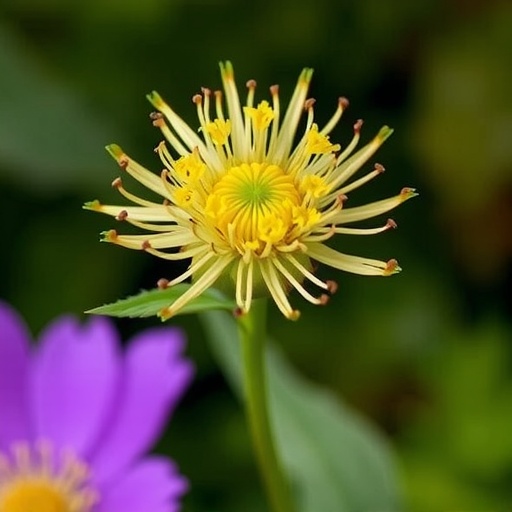In the realm of cellular biology, the establishment of polarity stands as a cornerstone of eukaryotic life. This process, which ensures spatial organization and directional growth, is fundamental across species. Among plants, the phenomenon of polarity takes on a particularly crucial role during pollen germination—a fundamental stage for plant reproduction. Intriguingly, polarity not only orchestrates developmental efficacy but also acts as a selective barrier influencing species compatibility. Today, cutting-edge research unveils a transformative insight into the molecular ballet underpinning this essential biological event.
At the heart of this discovery lies the intricate interplay between Rho of plants (ROPs) and their guanine nucleotide exchange factor 8 (RopGEF8) in Arabidopsis thaliana. These molecular players are vital for initiating pollen germination, operating via a precisely orchestrated polar distribution on the plasma membrane. This asymmetric localization triggers downstream signaling cascades that translate molecular cues into the physical manifestation of polarity. Despite profound knowledge surrounding the activation of ROPs by RopGEF8, the upstream mechanisms directing RopGEF8’s own localization remained elusive—until now.
Groundbreaking research has identified the pivotal role of Rab5 GTPases, a family of small GTP-binding proteins previously recognized for their functions in vesicular trafficking, as master regulators of pollen germination polarity. Unlike conventional pathways that involve Rab5’s guanine nucleotide exchange factors (GEFs) to toggle their activity states, this novel mechanism circumvents such intermediates. Instead, Rab5 GTPases appear to directly engage with RopGEF8, guiding its transport from endosomal compartments to the plasma membrane in a manner independent of their canonical GEFs.
This unconventional mode of interaction challenges classical paradigms of Rab GTPase functionality. Typically, Rab5 GTPases cycle between active GTP-bound and inactive GDP-bound states modulated by GEFs and GAPs, regulating vesicle formation and trafficking. The discovery that Rab5’s influence on RopGEF8 distribution is uncoupled from their own GEF activation suggests a unique evolutionary adaptation within the plant kingdom—one that exploits Rab5’s versatile trafficking capabilities to finetune cellular polarity beyond traditional vesicular transport roles.
Functional synergy emerges between both canonical Rab5 forms and plant-unique Rab5 variants during pollen germination. This combinatory approach expands the regulatory repertoire, allowing the cell to modulate polarity establishment with remarkable precision. The dualistic employment of canonical and plant-specific Rab5 GTPases likely reflects an evolutionary strategy to integrate diverse intracellular and extracellular signals, culminating in tightly regulated pollen tube emergence.
The direct interaction between Rab5 GTPases and RopGEF8 also illuminates the spatial-trafficking nexus essential for polarity. Endosomes, historically relegated as mere transport intermediates, are now recognized as pivotal staging grounds where RopGEF8 is mobilized, readying it for targeting to the plasma membrane. By navigating RopGEF8 through these intracellular vesicles, Rab5 GTPases set the stage for localized ROP activation, orchestrating cytoskeletal rearrangements and vesicle dynamics essential for polarized growth.
This finely tuned mechanism bears broader implications for how plant cells interpret and integrate complex signals. The temporal and spatial control of ROP signaling via Rab5-mediated trafficking enables pollen to respond adaptively to both internal metabolic states and external environmental conditions. Such plasticity is crucial in plants, which must reconcile reproductive timing with fluctuating surroundings to maximize fitness and reproductive success.
Moreover, this discovery sheds light on the evolutionary trajectory of polarity regulation in plants compared to other eukaryotes. While Rab5 GTPases serve conserved roles in vesicle transport across kingdoms, their co-option to directly manipulate ROP signaling pathways through non-canonical means appears to be a hallmark of plant innovation. This insight deepens our understanding of how molecular versatility drives the emergence of complex cellular behaviors unique to certain lineages.
From a practical perspective, unraveling the molecular underpinnings of pollen germination polarity opens avenues for agricultural innovation. Modulating the Rab5-ROP axis could enhance fertilization efficiency or introduce novel barriers to interspecies hybridization, offering tools for crop improvement and biodiversity conservation. Understanding these pathways at an intricate level primes future research targeting reproductive development and plant breeding technologies.
In experimental terms, the elucidation of Rab5’s role was achieved through a combination of genetic, biochemical, and imaging techniques. Molecular interaction assays confirmed the direct binding between Rab5 GTPases and RopGEF8, while advanced live-cell imaging tracked the dynamics of their intracellular trafficking. Mutational analyses disrupting Rab5 function demonstrated pronounced defects in pollen germination polarity, underscoring their essential role beyond theoretical associations.
Additionally, this research underscores the importance of endosomal trafficking hubs as centers of signal transduction rather than mere cargo carriers. The active participation of Rab5 in spatially orienting signaling molecules like RopGEF8 heralds a paradigm in which vesicular traffic and signal transduction are intimately linked. Such insights may extend beyond plant biology, informing broader cellular mechanisms where trafficking intermediates influence signaling landscapes.
This discovery also inspires questions about how other small GTPases might be repurposed to regulate signaling pathways through trafficking processes. The Rab5-ROP interplay may represent just one node in a complex network integrating vesicle trafficking and signal modulation. Future research is poised to unravel these networks, potentially revealing universal principles governing cellular polarity in diverse organisms.
Ultimately, the study of Rab5 GTPases and RopGEF8 in Arabidopsis pollen germination exemplifies the convergence of cell biology, molecular genetics, and evolutionary innovation. It illustrates how canonical trafficking machinery can be harnessed in novel ways to meet the specific demands of plant reproductive development, a dance of molecules choreographed with exquisite precision to perpetuate life.
As we deepen our understanding of the molecular frameworks guiding polarity, we not only expand fundamental biological knowledge but also open doors to harnessing these mechanisms in practical applications. The Rab5-mediated targeting of ROP signaling represents a milestone, showcasing how cellular machinery evolves versatility to orchestrate life’s critical processes—revealing a sophisticated cellular lexicon still only beginning to be deciphered.
Subject of Research: Regulation of pollen germination polarity via Rab5 GTPase-mediated targeting of ROP signaling in Arabidopsis thaliana
Article Title: Rab5 GTPases mediate the targeting of ROP signalling to establish polarity for pollen germination
Article References:
Hao, GJ., Yu, F., Liang, Zz. et al. Rab5 GTPases mediate the targeting of ROP signalling to establish polarity for pollen germination. Nat. Plants (2025). https://doi.org/10.1038/s41477-025-02130-6
Image Credits: AI Generated




